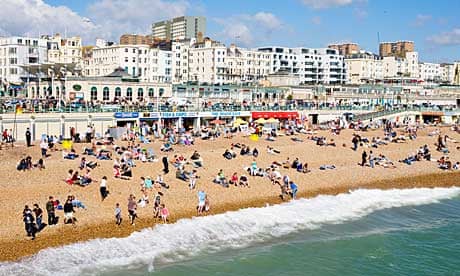The time to go swimming from British beaches was last year. The quality of bathing water around the UK coast improved markedly in 2013, after suffering a steep decline in 2012, because of the poor weather and floods that summer.
This year's water quality, while likely to be good across much of the country, could still be affected in some places if summer floods return. Floods can overwhelm sewage systems, causing outflow to rivers that reach and contaminate coastal waters. That was exacerbated in 2012 because the wet weather followed a long period of drought, which had left drying out sewage back in pipes, which was then discharged as the heavy rain fell.
But the beach water quality analysis, published annually by the European Environment Agency, only collates information on bacteria that indicates pollution from sewage or livestock. It does not take account of beach litter, such as plastics thrown up by the sea or rubbish discarded by beach visitors, which are an increasing blight on UK beaches, according to experts such as the Marine Conservation Society. So you might still turn up at an excellent rated beach to find it covered in plastic bags full of dog poo thoughtfully left by walkers.
Only seven out of 616 beaches in Britain, or 1.1% of the total, were rated of poor bathing water quality for 2013, in the survey by Europe's environmental watchdog, compared with 36, or 5.8%, in the previous year's analysis. In 2012, many beaches were badly affected by sewage outflows caused by the poor weather.
But the proportion of coastal bathing sites deemed excellent has not quite regained its pre-2012 peak, with 496, or 80.5% reaching that status, compared with more than 83% in 2011 from a slightly smaller sample. In 2012, the proportion of excellent beaches plummeted to 58.8%. The remainder were rated as of sufficient quality to meet EU standards.
Inland bathing waters, of which only 13 were sampled, showed full compliance with the standards, but only four were deemed excellent, down from seven in 2010 and 2011.
Cyprus had the cleanest bathing water in Europe, with all of its sites rated excellent, closely followed by Malta, while Croatia had 95% and Greece had 93% of sites at the highest standard. Ireland, France and Spain came in near the bottom of the league table, with bathing water quality in Europe, with 3% of beaches rated as poor.
Janez Potočnik, the EU environment commissioner, said: "It's good that the quality of European bathing waters continues to be of a high standard. But we cannot afford to be complacent with such a precious resource as water. We must continue to ensure that our bathing and drinking water as well as our aquatic ecosystems are fully protected."
Beaches have been cleaned up massively in the past two decades, after many years in which untreated sewage was allowed to be discharged into the water, resulting in widespread pollution. Sewage and pollution from livestock contains bugs that can cause vomiting and diarrhoea.
Hans Bruyninckx, executive director of the European Environment Agency, said: "We are no longer discharging such high quantities of sewage directly into water bodies. Today's challenge comes from short-term pollution loads during heavy rain and flooding. This can overflow sewage systems and wash faecal bacteria from farmland into the rivers and seas."
In the UK, this can be a particular problem because of the way in which some sewage systems work, including the Thames, by allowing outfalls of sewage into rivers if the sewage pipes are full. This can help to prevent some.
Overall in Europe, 95% of bathing sites met the minimum standards while eight in ten were rated excellent, and only 2% of all sites were rated as poor. The proportion of excellent sites has increased from 2012, from 79% to 83% in 2013.
Luxembourg was the only country to rate excellent for all its inland sites, while Denmark achieved 94% at the highest rating and Germany, with a high number of inland sites at nearly 2,000, followed closely with more than nine out of ten of them excellent.

Comments (…)
Sign in or create your Guardian account to join the discussion